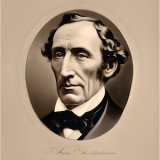The Fir Tree Page #2
"The Fir Tree" by Hans Christian Andersen is a classic children's tale that centers around a small fir tree in the forest who dreams of growing up. The tree wishes to become grand and tall like its peers. Throughout different seasons and with every different group of visitors to the forest, the tree learns more about life and its own existence. When it is finally cut down and decorated for Christmas, it continues to dream of better days ahead, only to eventually realise its precious past moments in the forest. This poignant tale illustrates Andersen's unique ability to write a deeply insightful narrative cloaked in a simple children's story form.
trees of the forest come to see me? I wonder if the sparrows will peep in at the windows as they fly? shall I grow faster here, and keep on all these ornaments summer and winter?" But guessing was of very little use; it made his bark ache, and this pain is as bad for a slender fir-tree, as headache is for us. At last the tapers were lighted, and then what a glistening blaze of light the tree presented! It trembled so with joy in all its branches, that one of the candles fell among the green leaves and burnt some of them. "Help! help!" exclaimed the young ladies, but there was no danger, for they quickly extinguished the fire. After this, the tree tried not to tremble at all, though the fire frightened him; he was so anxious not to hurt any of the beautiful ornaments, even while their brilliancy dazzled him. And now the folding doors were thrown open, and a troop of children rushed in as if they intended to upset the tree; they were followed more silently by their elders. For a moment the little ones stood silent with astonishment, and then they shouted for joy, till the room rang, and they danced merrily round the tree, while one present after another was taken from it. "What are they doing? What will happen next?" thought the fir. At last the candles burnt down to the branches and were put out. Then the children received permission to plunder the tree. Oh, how they rushed upon it, till the branches cracked, and had it not been fastened with the glistening star to the ceiling, it must have been thrown down. The children then danced about with their pretty toys, and no one noticed the tree, except the children's maid who came and peeped among the branches to see if an apple or a fig had been forgotten. "A story, a story," cried the children, pulling a little fat man towards the tree. "Now we shall be in the green shade," said the man, as he seated himself under it, "and the tree will have the pleasure of hearing also, but I shall only relate one story; what shall it be? Ivede-Avede, or Humpty Dumpty, who fell down stairs, but soon got up again, and at last married a princess." "Ivede-Avede," cried some. "Humpty Dumpty," cried others, and there was a fine shouting and crying out. But the fir-tree remained quite still, and thought to himself, "Shall I have anything to do with all this?" but he had already amused them as much as they wished. Then the old man told them the story of Humpty Dumpty, how he fell down stairs, and was raised up again, and married a princess. And the children clapped their hands and cried, "Tell another, tell another," for they wanted to hear the story of "Ivede-Avede;" but they only had "Humpty Dumpty." After this the fir-tree became quite silent and thoughtful; never had the birds in the forest told such tales as "Humpty Dumpty," who fell down stairs, and yet married a princess. "Ah! yes, so it happens in the world," thought the fir-tree; he believed it all, because it was related by such a nice man. "Ah! well," he thought, "who knows? perhaps I may fall down too, and marry a princess;" and he looked forward joyfully to the next evening, expecting to be again decked out with lights and playthings, gold and fruit. "To-morrow I will not tremble," thought he; "I will enjoy all my splendor, and I shall hear the story of Humpty Dumpty again, and perhaps Ivede-Avede." And the tree remained quiet and thoughtful all night. In the morning the servants and the housemaid came in. "Now," thought the fir, "all my splendor is going to begin again." But they dragged him out of the room and up stairs to the garret, and threw him on the floor, in a dark corner, where no daylight shone, and there they left him. "What does this mean?" thought the tree, "what am I to do here? I can hear nothing in a place like this," and he had time enough to think, for days and nights passed and no one came near him, and when at last somebody did come, it was only to put away large boxes in a corner. So the tree was completely hidden from sight as if it had never existed. "It is winter now," thought the tree, "the ground is hard and covered with snow, so that people cannot plant me. I shall be sheltered here, I dare say, until spring comes. How thoughtful and kind everybody is to me! Still I wish this place were not so dark, as well as lonely, with not even a little hare to look at. How pleasant it was out in the forest while the snow lay on the ground, when the hare would run by, yes, and jump over me too, although I did not like it then. Oh! it is terrible lonely here." "Squeak, squeak," said a little mouse, creeping cautiously towards the tree; then came another; and they both sniffed at the fir-tree and crept between the branches. "Oh, it is very cold," said the little mouse, "or else we should be so comfortable here, shouldn't we, you old fir-tree?" "I am not old," said the fir-tree, "there are many who are older than I am." "Where do you come from? and what do you know?" asked the mice, who were full of curiosity. "Have you seen the most beautiful places in the world, and can you tell us all about them? and have you been in the storeroom, where cheeses lie on the shelf, and hams hang from the ceiling? One can run about on tallow candles there, and go in thin and come out fat." "I know nothing of that place," said the fir-tree, "but I know the wood where the sun shines and the birds sing." And then the tree told the little mice all about its youth. They had never heard such an account in their lives; and after they had listened to it attentively, they said, "What a number of things you have seen? you must have been very happy." "Happy!" exclaimed the fir-tree, and then as he reflected upon what he had been telling them, he said, "Ah, yes! after all those were happy days." But when he went on and related all about Christmas-eve, and how he had been dressed up with cakes and lights, the mice said, "How happy you must have been, you old fir-tree." "I am not old at all," replied the tree, "I only came from the forest this winter, I am now checked in my growth." "What splendid stories you can relate," said the little mice. And the next night four other mice came with them to hear what the tree had to tell. The more he talked the more he remembered, and then he thought to himself, "Those were happy days, but they may come again. Humpty Dumpty fell down stairs, and yet he married the princess; perhaps I may marry a princess too." And the fir-tree thought of the pretty little birch-tree that grew in the forest, which was to him a real beautiful princess. "Who is Humpty Dumpty?" asked the little mice. And then the tree related the whole story; he could remember every single word, and the little mice was so delighted with it, that they were ready to jump to the top of the tree. The next night a great many more mice made their appearance, and on Sunday two rats came with them; but they said, it was not a pretty story at all, and the little mice were
Translation
Translate and read this book in other languages:
Select another language:
- - Select -
- 简体中文 (Chinese - Simplified)
- 繁體中文 (Chinese - Traditional)
- Español (Spanish)
- Esperanto (Esperanto)
- 日本語 (Japanese)
- Português (Portuguese)
- Deutsch (German)
- العربية (Arabic)
- Français (French)
- Русский (Russian)
- ಕನ್ನಡ (Kannada)
- 한국어 (Korean)
- עברית (Hebrew)
- Gaeilge (Irish)
- Українська (Ukrainian)
- اردو (Urdu)
- Magyar (Hungarian)
- मानक हिन्दी (Hindi)
- Indonesia (Indonesian)
- Italiano (Italian)
- தமிழ் (Tamil)
- Türkçe (Turkish)
- తెలుగు (Telugu)
- ภาษาไทย (Thai)
- Tiếng Việt (Vietnamese)
- Čeština (Czech)
- Polski (Polish)
- Bahasa Indonesia (Indonesian)
- Românește (Romanian)
- Nederlands (Dutch)
- Ελληνικά (Greek)
- Latinum (Latin)
- Svenska (Swedish)
- Dansk (Danish)
- Suomi (Finnish)
- فارسی (Persian)
- ייִדיש (Yiddish)
- հայերեն (Armenian)
- Norsk (Norwegian)
- English (English)
Citation
Use the citation below to add this book to your bibliography:
Style:MLAChicagoAPA
"The Fir Tree Books." Literature.com. STANDS4 LLC, 2025. Web. 22 Jan. 2025. <https://www.literature.com/book/the_fir_tree_2165>.




Discuss this The Fir Tree book with the community:
Report Comment
We're doing our best to make sure our content is useful, accurate and safe.
If by any chance you spot an inappropriate comment while navigating through our website please use this form to let us know, and we'll take care of it shortly.
Attachment
You need to be logged in to favorite.
Log In